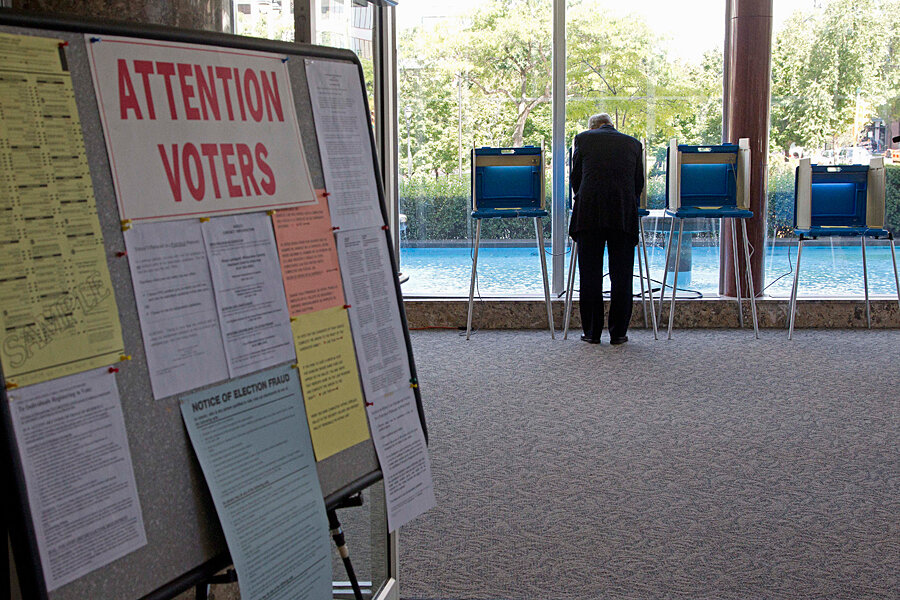Why frustrated Latinos may not turn out to vote in midterms
Loading...
For the first time in US history, Latinos make up 11 percent of all eligible voters nationwide – a record 25.2 million people in all. But their potential clout in the midterm elections, and in deciding which party controls the Senate, could be diminished by several factors.
The Hispanic electorate is one of the fastest-growing voter groups in the country, rising from 8.6 percent of all US voters in 2006, to 10.1 percent in 2010, to 11 percent in 2014. But according to a new report from the Pew Research Center, it's unlikely that this growing demographic will have a big impact on Nov. 4.
The Pew report identified eight "competitive" Senate races – contests that will be key in determining whether control of the upper chamber shifts to the Republicans. In theory, the growing Hispanic electorate could determine the winner in tight Senate races, which would then determine who controls the chamber for the next two years.
However, Latinos are a small percentage of eligible voters in most of these races and are thus unlikely to be the decisive group, according to the Pew report.
The average percentage of eligible Latino voters in the eight states is just 4.7 percent of all eligible voters. There are only two competitive Senate races where Hispanics could have a decisive impact, according to the report: Colorado and Kansas. Still, Latinos make up only 6 percent of eligible voters in Kansas, although in Colorado the figure is 14.2 percent.
"The impact of Latino voters in determining which party controls the US Senate may not be as large as might be expected given their growing electoral and demographic presence nationwide," the Pew report said.
A poll by Quinnipiac University on the Colorado race shows Republican challenger Cory Gardner leading incumbent Sen. Mark Udall (D) 47 to 41 percent among likely voters. But the question of whether Hispanics in Colorado as well as elsewhere are "likely voters" is a compelling one.
Despite their rapid growth into a key electoral demographic, Hispanic voter turnout has lagged behind other racial and ethnic groups, according to the Pew report. In the 2010 midterm elections, for example, a record 6.6 million Hispanics voted, but that made up only 31.2 percent of Hispanic eligible voters. That percentage compared with 48.6 percent of white and 44 percent of black eligible voters.
This weaker turnout rate is due to a number of factors, in particular the average age of Hispanic voters and the states where most of them live. Young people turn out for elections at lower rates than older eligible votes across all racial and ethnic groups, according to a 2013 study from the Center for Information and Research on Civic Learning and Engagement (CIRCLE). But Hispanic eligible voters are on average much younger than other groups.
This year, 33 percent of Hispanic eligible voters are ages 18 to 29. Only 18 percent of white eligible voters are in that age group, while that age group supplies 25 percent of black and 21 percent of Asian eligible voters.
Most Hispanic voters are also in uncompetitive states, like California and Texas, meaning they do not receive much attention from campaigns and thus could be less motivated to vote.
In addition, many Latinos have been turned off by recent policy actions, and inaction, by both Republicans and Democrats. In particular, the failure of efforts to overhaul federal immigration policy has upset many Hispanics. But they are not only angry at the Republican-led House for stalling on immigration reform, but also at President Obama for not taking any executive action on the issue.
"They're telling us left and right that they're disappointed the president didn't act on immigration," Leo Murrieta, national field director for Mi Familia Vota, told The Wall Street Journal. "But even more, that the Republican House didn't do anything."
With the Hispanic electorate still so young, its voting power is only expected grow. By 2030, the number of Hispanic eligible voters is projected to exceed 40 million, according to the Pew report, so Latinos will probably have more influence in future elections.








